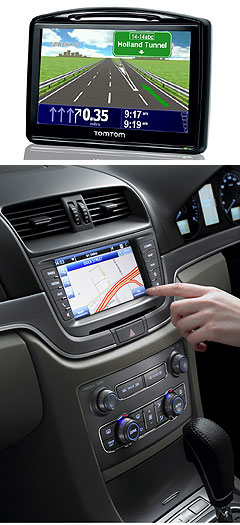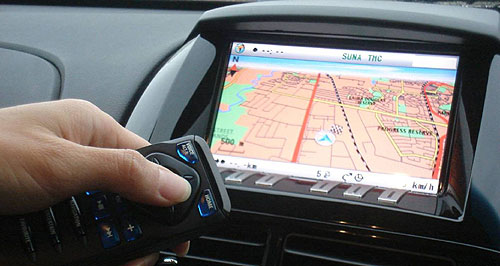Make / Model Search
News - General NewsTelematics here later rather than SUNASmart map: Australia lags well behind other western nations for vehicle telematics take-up. Oz telematics firm urges smart navigation for all by streamlining, adding content11 Mar 2011 THE AUSTRALIAN company behind the SUNA traffic information service says that 80 per cent of car-makers have committed to offering the potentially time saving and traffic reducing technology in their satellite navigation-equipped vehicles, but that long model development cycles will see some models wait years. Intelematics Australia hopes to expand the availability of high-tech telematics systems similar to the ConnectedDrive service offered in high-end BMWs to buyers of mass-market, affordable cars in Australia. First seen here in Ford’s homegrown FG Falcon in 2008 and variants of Nissan’s X-Trail and Patrol fitted with sat-nav, the traffic and speed camera-dodging SUNA service can now be accessed in Holden VEII Commodores fitted with the iQ system, Honda’s Insight VTi-L hybrid and Toyotas fitted with the TomTom-based FollowMe in-dash navigation unit. Mercedes-Benz, Mitsubishi and Subaru are also set to follow suit with the system in some of their vehicles, but the technology remains niche in Australia whereas it is now standard in around 50 per cent of vehicles sold in other developed markets. Intelematics CEO Adam Game told GoAuto the company - which plans to roll out its services internationally, primarily in the Asia-Pacific region - is encouraging vehicle manufacturers to introduce telematics to Australia more quickly by providing compatible infrastructure and local content for their in-car systems to connect with. “Most of what we do is encourage car-makers to view bringing the technology to the Australian market as being less overwhelming than they might have otherwise thought,” he said. “The difficulty facing car-makers has been justifying the cost of localising the technology for the Australian market, making it very tempting for them to simply de-specify it.” SUNA was launched in Melbourne in 2007 as the first digital provider of traffic information for Australian cities to satellite-navigation systems and online maps. Since then service has been rolled out to Adelaide, Brisbane, Canberra, the Gold Coast, Perth and Sydney, while Darwin and Hobart remain in the planning stage. The SUNA service isn’t limited to in-car devices as Google, NineMSN and Nokia all offer its traffic data on their internet-based map services and Nokia navigation-enabled smartphones also receive the service. Intelematics claims that on average 54 per cent of aftermarket GPS units sold in Australia are now SUNA-compatible and predicts the number sold since the system’s launch will exceed 3.5 million by the end of the current financial year. A growing number of aftermarket standalone units from brands including Garmin, TomTom, Navman are also compatible with the SUNA service although some require the addition of an external antenna or specially-equipped cradle in order to receive traffic data broadcasts. Mr Game said the shift by auto-makers from ‘embedded’ connectivity, where the vehicle has its own in-built telecommunications hardware, to ‘tethered’ connectivity that uses Bluetooth or a USB socket to transfer data from an occupant’s internet-enabled mobile device – which is now available on about 50 per cent of new cars available in Australia – will aid the uptake of telematics by overcoming differences in international telecommunications standards. He said that Intelematics is working with manufacturers at the hardware development level to make sure the technology will work in Australia by achieving economies of scale that would be impossible with a bespoke, country-specific solution. Mr Game said the company also helps the industry provide local and context-specific content information services for their in-car systems.  “While some services are not country-specific, for example access to social networking, others, such as finding the cheapest fuel within five kilometres or the quickest route to a given destination at a specific time of day, require access to local input and that’s our specialty.” Intelematics was founded 11 years ago as a joint-venture between the RACV and NRMA, which became a silent investor shortly after demutualisation, making the company a subsidiary of the RACV. The SUNA service recently won the Victorian government’s road transport innovation prize. Intelematics has long provided ‘first generation’ telematics services to Holden, Mitsubishi and Toyota, offering various emergency services via hands-free communication with a dedicated support centre. In applications such as Holden Assist, it can unlock a vehicle remotely if the driver is locked out, track the car while alerting the police if it is stolen and even set a perimeter outside of which the car cannot be driven without alerting the owner and the authorities. Other benefits include the ability to receive messages on the in-car screen or fleet management tools for the driver to select whether a journey is private or business to provide an ATO-approved log book and fringe benefit tax calculator. The systems are fully integrated with the car’s central nervous system (known as the CAN-bus) and as such are able to provide the remote monitoring of engine parameters, driver behaviour and even receive software updates for the various on-board control systems. The second generation of the technology, which Intelematics is keen to help make reality in Australia, provides significant safety benefits, such as detecting the deployment of airbags in a crash and immediately alerting the emergency services while providing them with the vehicle’s location. However the real consumer buzz will come from the increasing possibilities for in-car ‘infotainment’ that will see vehicles benefiting from a constant connection with the internet. “Customer expectations are increasingly driven by the smartphone revolution, but smartphones are not necessarily optimised for use inside a vehicle,” said Mr Game. “There are some points of integration with vehicles that make sense and there’s a range of opportunities for the car companies to offer these to their customers.” He cited performing a Google maps search on a home computer and then sending the destination to the car, checking in on Facebook from inside the vehicle and being notified of nearby friends as examples of how the technology could be used. SUNA broadcasts live traffic data to compatible in-car satellite-navigation devices, which can then re-route the driver to avoid snarl-ups, roadworks, public events and even bad weather to reduce their impact on journey times. The data is collated from several sources, including traffic speed monitoring cameras, verified witness reports, traffic light sensors (which is a unique feature of the SUNA system) and a fleet of ‘probe’ vehicles comprising taxis, road service vehicles, courier vans and coaches plus some private GPS-equipped vehicles. A feed from emergency services, road authorities and vehicle recovery companies is also taken into account. A ‘SUNA traffic operations hub’ collects and processes the data automatically 24 hours per day (with human input for anecdotal reports), before transmitting it over the FM radio network. To widen the number of compatible devices, a mobile internet feed also exists for smartphone apps such as Sygic Mobile Maps and Aura Drive. Mr Game said that while the SUNA system relies on existing technology to deliver traffic information to vehicles, the information gathering and processing part was developed in Australia for the unique traffic conditions that exist here. In Europe, similar systems focus on the frequently-congested major roads between towns and cities, while in the US they are designed for use on city freeway networks. Traffic is not a problem between Australia’s far-flung cities but in urban areas it uniquely tends to travel on arterial roads, which is why the system of collecting data from traffic light sensors was uniquely developed for this country. Intelematics is now focussing on continuing to improve SUNA’s comprehensiveness and precision through the addition of additional ‘probe’ vehicles that constantly feed location and speed data back into the system. Mr Game said the company has been recruiting taxi fleets to help with this but a growing percentage of private vehicle owners are also contributing using what he calls ‘passive crowd sourcing’. Some customers receive the SUNA service through a mobile internet connection either because they are using a smartphone or their GPS device works that way. These users can opt into a two-way agreement, rather like the application crash reporting on a computer, to provide data while they travel. If the system receives contradictory information that there is a blockage on a particular stretch of road while several probe vehicles are reporting that they are travelling along it at speed, the system automatically deduces whether the problem exists or not and broadcasts an update to reflect that. The service is provided for the lifetime of the receiving equipment and funded through a royalty paid by the manufacturer of each SUNA-compatible device sold. The broadcasts are encrypted to prevent free access to royalty-free imported devices that would otherwise be compatible with the system. And Smartphone navigation apps usually come with a paid subscription to the service.  Read more23rd of November 2010  Insight to take hybrid fight to PriusInsight finally arrives as Australia’s cheapest hybrid as Honda eyes Toyota Prius11th of September 2010  First drive: Holden iQ and E85 evolve Commodore breedWe drive Holden’s ethanol-ready, higher-tech Series II Commodore range20th of August 2007  Sat-nav gets smartNew sat-nav service helps drivers steer clear of gridlock |
Click to shareGeneral News articlesResearch General News Motor industry news |









Facebook Twitter Instagram